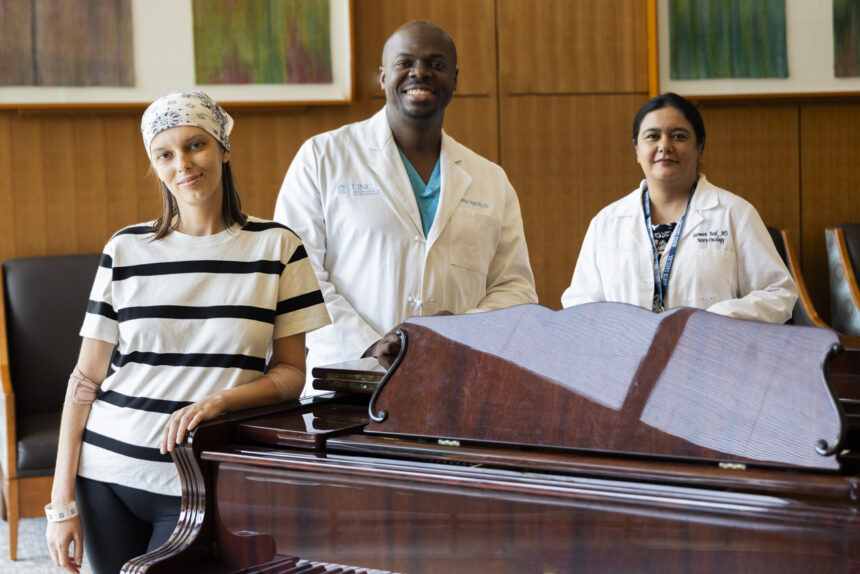Hanna was 29 when a sudden series of seizures left her unconscious at home in Florida, where she lived after arriving in the United States from Ukraine in fall 2022. Her friends rushed her to the hospital, and she found out she had a glioma, a type of brain tumor.
“It was a surprise for me and my family, because I had no other symptoms of disease ever in my life,” Hanna says. “I was healthy. I was going to the gym three times a week.”
After she moved to North Carolina to be near her brother, his host family recommended Hanna go to UNC Health, where she met with UNC Health neurosurgical oncologist Dominique Higgins, MD, PhD, to discuss her treatment options.
Dr. Higgins and UNC Health neuro-oncologist Yasmeen Rauf, MD, share what gliomas are, how they’re treated and how Hanna is doing now.
What is a glioma?
A glioma is a primary brain tumor, meaning it forms in the brain as opposed to spreading to the brain from another part of the body. It can be benign, but it is usually malignant (cancerous). The mass of cells originates in the glial cells of the brain and spinal cord. Gliomas are the most common primary brain tumor in adults.
“Gliomas have the potential to grow quickly, and they can be life-threatening,” Dr. Higgins says.
There are four grades of gliomas. Grade 1 is benign, and grades 2 through 4 are malignant. Grade 4, called glioblastoma, is the most severe and the most common. “Glioblastomas are very aggressive and incurable,” Dr. Rauf says. “The average life expectancy for glioblastoma is 15 to 18 months.”
Hanna’s tumor was a grade 2, so the expectation is that it would grow more slowly and have a more favorable outcome.
What are the symptoms of a glioma?
Symptoms of a glioma will vary depending on the location of the tumor. As the cells grow, they start to press into important parts of the brain and spinal cord.
“For example, if the tumor is near the part of the brain that controls movement, you might start to see weakness,” Dr. Higgins says. “If it’s near the language part of the brain, you may have trouble with words. If it’s close to the front of the brain, you could see personality changes.”
Common symptoms of glioma include:
- Headaches
- Memory problems
- Nausea
- Blurry vision
- Speech changes
- Seizures
- Weakness on one side of the body
- Changes in gait (walking)
Contact your doctor if you notice any of these symptoms.
Who is at risk of getting a glioma?
While gliomas are relatively rare (6 out of 100,000 cases are diagnosed every year), anyone can get one.
Generally, brain tumors are more common in adults and white people, Dr. Rauf says. They are also more common in men than women.
A history of prior radiation exposure and some rare genetic disorders such as Lynch syndrome, neurofibromatosis and Li-Fraumeni syndrome raise a person’s risk.
How are gliomas treated?
For most primary brain tumors, surgery is needed to remove as much of the tumor as possible. The person will usually undergo six weeks of radiation and chemotherapy, followed by six to 12 months of chemotherapy, in particular when the whole tumor cannot be safely removed.
“Patients with benign or low-grade treatment typically respond well and generally can be on surveillance for a very long time,” Dr. Rauf says. “Patients with high-grade glioma, such as glioblastoma, usually remain on some form of treatment.”
Surgery to remove gliomas requires extreme precision, as the surgeon must be careful not to disturb the surrounding brain functions. For Hanna, the tumor was large and close to the language and movement areas of the brain.
“When the tumor is near important structures, I do the surgery while the patient is awake,” Dr. Higgins says. “That way, I can test function as I’m removing the tumor. Our team is great at making sure patients are comfortable during the testing. Hanna did very well with the surgery.”
What doctors are best to treat a glioma?
When selecting a surgeon for glioma removal, choose one who is part of a robust neuro-oncology team. Dr. Higgins collaborated with neurologists, neuropsychologists and neurophysiologists to map Hanna’s English and Ukrainian language centers before surgery to ensure the best outcome.
Hanna’s surgery was successful, and she was able to go home after only one night in the hospital.
She was then referred to Dr. Rauf to manage her radiation and chemotherapy treatment. Dr. Rauf collaborated with neurosurgeons, radiation oncologists and neuro-oncologists to formulate Hanna’s treatment plan.
“I’m on my second round of chemotherapy, and I feel pretty good,” Hanna says. “I’m not experiencing side effects. I’m thankful for the care I’ve received.”
What’s next for glioma care?
Because there is no cure for gliomas and it’s unknown what causes them, more research is needed. Clinical trials are underway at UNC Health and other academic medical centers across the country to discover new treatments and find ways to slow the cancer’s growth.
If you have questions about your health, talk to your doctor. Need a doctor? Find one near you.

